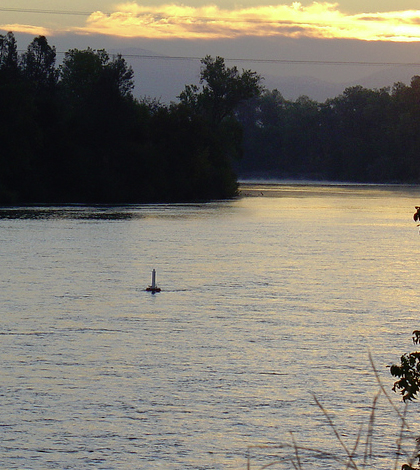New Buoys Mean Algae Bloom Monitoring Network For Grand Lake O’ The Cherokees

MB-300 at sunset. (Credit: NexSens Technology)
During the summer vacation season, as well as on many major holidays, Grand Lake o’ the Cherokees becomes what some jokingly say is the third largest city in Oklahoma. That’s because people flock to it from near and far, swelling the area’s population to numbers that rival those in actual cities like Oklahoma City and Tulsa.
“It’s sort of a joke, but not really. Over the fourth of July or Labor Day, it’s packed to the hilt,” said Jason Murphy, rivers and streams project coordinator at the Oklahoma Water Resources Board. He works in the Resources Board’s Water Quality Programs Division that helps oversee monitoring of waterways under the charge of the Grand River Dam Authority, including Grand Lake and all around Pensacola Dam that holds it back.
Murphy says the abundance of visitors to the lake means there is a lot of primary body contact for those swimming or boating there. And keeping the water in good shape is clearly an important concern for public safety.
“In the past, they have had some (algal blooms). July 2011 was the last big one,” said Murphy. “It was kind of a big deal because they had to shut down the lake on the fourth of July. And it became a hot-button issue. Some people thought GRDA was being overly cautious or not cautious enough.”
Nevertheless, keeping beachgoers informed of water quality conditions in Grand Lake is important, perhaps none as important as alerting them to algal blooms. Thanks to large-scale harmful blooms impacting lakes in the United States, particularly Lake Erie, many have seen the implications that toxic blooms can have: no-contact warnings, beach closures and drinking water advisories.

Grand Lake o’ the Cherokees. (Credit: JDMcGreg/CC BY-SA 3.0)
To help keep an eye on those things, the Oklahoma Water Resources Board will be launching four NexSens MB-300 Data Buoys in Grand Lake o’ the Cherokees this October. Platforms will be placed in each corner of the lake and equipped with YSI 6600 Multi-Parameter Water Quality Sondes to monitor temperature, conductivity, pH, dissolved oxygen, chlorophyll and blue-green algae. NexSens SDL500C Submersible Data Loggers with cellular telemetry will gather the data and transmit them back to GRDA officials.
“They’ll work the same way our DO monitoring stations do and report data every 15 minutes. A threshold will be set and it will send out an alarm that GRDA should go out and collect samples,” said Murphy.
In addition, Murphy says the data will be shared with researchers around the lake, including those at the University of Oklahoma and Oklahoma State University who are embarking on and continuing other lake studies into its algae.
“They are wanting to make the data from the buoys available through a web portal to the general public in real time as well as use the data for larger watershed studies taking place at both universities,” said Murphy. “GRDA has agreed to put the buoys in to further that goal as well as increase the amount of data available for their own lake studies.”
He adds that data from the sondes could also be used for remote-sensing applications in the Grand Lake watershed and other similar watersheds nearby. The Resources Board will also use the buoy data in its annual reports.
Top image: MB-300 at sunset. (Credit: NexSens Technology)




Pingback: Oklahoma State University researchers develop cheap, accessible way to monitor water for harmful algae - geeksscience